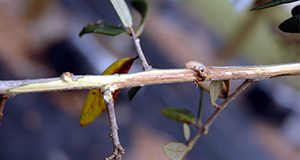
Metsulfuron-methyl, also known as MSM, is an herbicide that is used to control broadleaf weeds and certain grass weeds. It provides effective control of some of the most problematic turfgrass weeds, such as wild garlic, Florida betony, dollar weed, and small Virginia buttonweed. Metsulfuron-methyl is absorbed by plant foliage, so if landscape plants come into contact with the spray or drift they can be injured. This four-page fact sheet describes the potential problems with metsulfuron herbicides, the areas most subsceptible to damage, how to diagnose injury, and how to reduce damage. Written by Chris Marble, Jason Smith, Timothy K. Broschat, Adam Black, Ed Gilman, and Celeste White and published by the School of Forest Resources and Conservation Department.
http://edis.ifas.ufl.edu/fr400
Tag: Celeste White
Growing Potatoes in the Florida Home Garden (HS993/HS183)
 The Irish potato is a cool-season crop. A recently grown and harvested potato exhibits different flavor profiles from one that has been in storage or on a grocery shelf for an extended period. For example, in storage, the starches in potatoes convert to sugars, resulting in a less desirable texture and taste. “New” potato flavor can be achieved in the home garden by following a few growing recommendations. This 9-page fact sheet was written by Christian T. Christensen, Libby R. Rens, Jeffrey E. Pack, Lincoln Zotarelli, Chad Hutchinson, Wendy Dahl, Doug Gergela, and James M. White, and published by the UF Department of Horticultural Sciences, April 2013.
The Irish potato is a cool-season crop. A recently grown and harvested potato exhibits different flavor profiles from one that has been in storage or on a grocery shelf for an extended period. For example, in storage, the starches in potatoes convert to sugars, resulting in a less desirable texture and taste. “New” potato flavor can be achieved in the home garden by following a few growing recommendations. This 9-page fact sheet was written by Christian T. Christensen, Libby R. Rens, Jeffrey E. Pack, Lincoln Zotarelli, Chad Hutchinson, Wendy Dahl, Doug Gergela, and James M. White, and published by the UF Department of Horticultural Sciences, April 2013.
http://edis.ifas.ufl.edu/hs183
ENH1135/EP396 Adopting a Florida-Friendly Landscape: Steps for Converting a Typical Development Landscape to a Florida-Friendly Landscape
ENH-1135, a 15-page illustrated fact sheet by Gail Hansen, Jennifer Ramos, E.A. Felter, and Celeste White, lays out a process of incorporating more trees and plants in three phases, to make a traditional development landscape more environmentally sound and Florida-Friendly. Includes references. Published by the UF Department of Environmental Horticulture, August 2009.
http://edis.ifas.ufl.edu/EP396